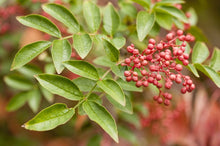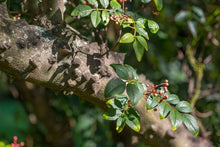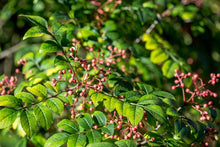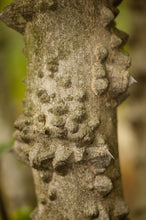Flatspine Szechuan Peppercorn
Regular price
$4.50
Sale
Zanthoxylum simulans
Origin: China
Improvement status: Landrace
Seeds per packet: ~50
BOTANICAL SAMPLE - NOT GERMINATION TESTED
Life cycle: Perennial
Also called Chinese prickly-ash, or Hua Jiao, this shrub or small tree produces the deliciously spicy/numbing Szechuan peppercorn, indispensable in some Chinese cooking. A few other closely related species also produce Szechuan peppercorns as well. Native to eastern China and Taiwan, this species is hardy to at least Zone 6 and above. It may grow to nearly 25 feet tall, but can also be pruned to remain more manageable. The whole fruit, composed of black seeds inside and rough red-brown shell that naturally splits open, is what is dried and used in Chinese cooking, either whole or powdered. It can be used as a table seasoning, replacing black pepper. Roasting apparently brings out even more flavor. The plant is also considered medicinal, with a resin from the bark and roots being used as a tonic and stimulant.
Szechuan peppercorns have a unique flavor, somewhat reminiscent of citrus (they are in the same Rutaceae family, along with all citrus, rue, and curry leaf), but with an earthiness, resinousness and warmth quite distinct from any other common food. But it's not really the flavor that attracts most people to Szechuan peppercorns: it's more the sensation it causes on the lips and in the mouth.
At once both numbing and stimulating, it's often defined as "tingly", or even like a mild electric shock. In China, the sensation is called "má". We don't have a word for it in English. Scientists believe it comes from a unique compound found in the plants called hydroxy-alpha-sanshool.
The shell of the fruit which surrounds the seed is the most potent part, and it can be ground, crushed, or used whole. It's sometimes utilized directly in dishes, but also can be soaked in oil and then the oil used.
For a long time, importing viable seeds of this species was illegal because they were believed to threaten our country's important citrus industry (thanks to a bacterial disease called "Citrus canker" or Xanthomonas citri). But scientists now know better and the blanket ban was finally lifted in 2005.
This is a temperate perennial tree or shrub that thrives across much of the US. We have a friend here in South Jersey who has nice mature bushes he's been growing for years.
One advantage to growing your own: the fresh fruit are even more potent than dried fruit. Commercially available peppercorns are also often heat-treated or irradiated, and they can sit in warehouses or in transit for many months or years before reaching your table, so the power is even less pronounced. The only way to get really fresh and vibrant Szechuan peppercorns is to grow your own!
These seeds were imported from China by the good folks at Sheffield's Seeds in Locke, NY.
GROWING TIPS: Seeds should be soaked for 24 hours, then cold-stratified for 120 days, before planting 1/8 inch deep. Happiest in zones 6-9, it will thrive in loamy soils that are well-drained but also retain moisture. It can handle full sun of partial shade.
NOTE ON NATURALIZING POTENTIAL: We've recently learned that this species has escaped cultivation in New York, Pennsylvania, and Maryland, so please exercise caution (including harvesting seeds as they ripen to prevent bird predation) if you live in a place where it might readily spread and keep an eye out for any errant plants.
Photos come from NC State's Extension Gardener Plant Toolbox information page about this species.








